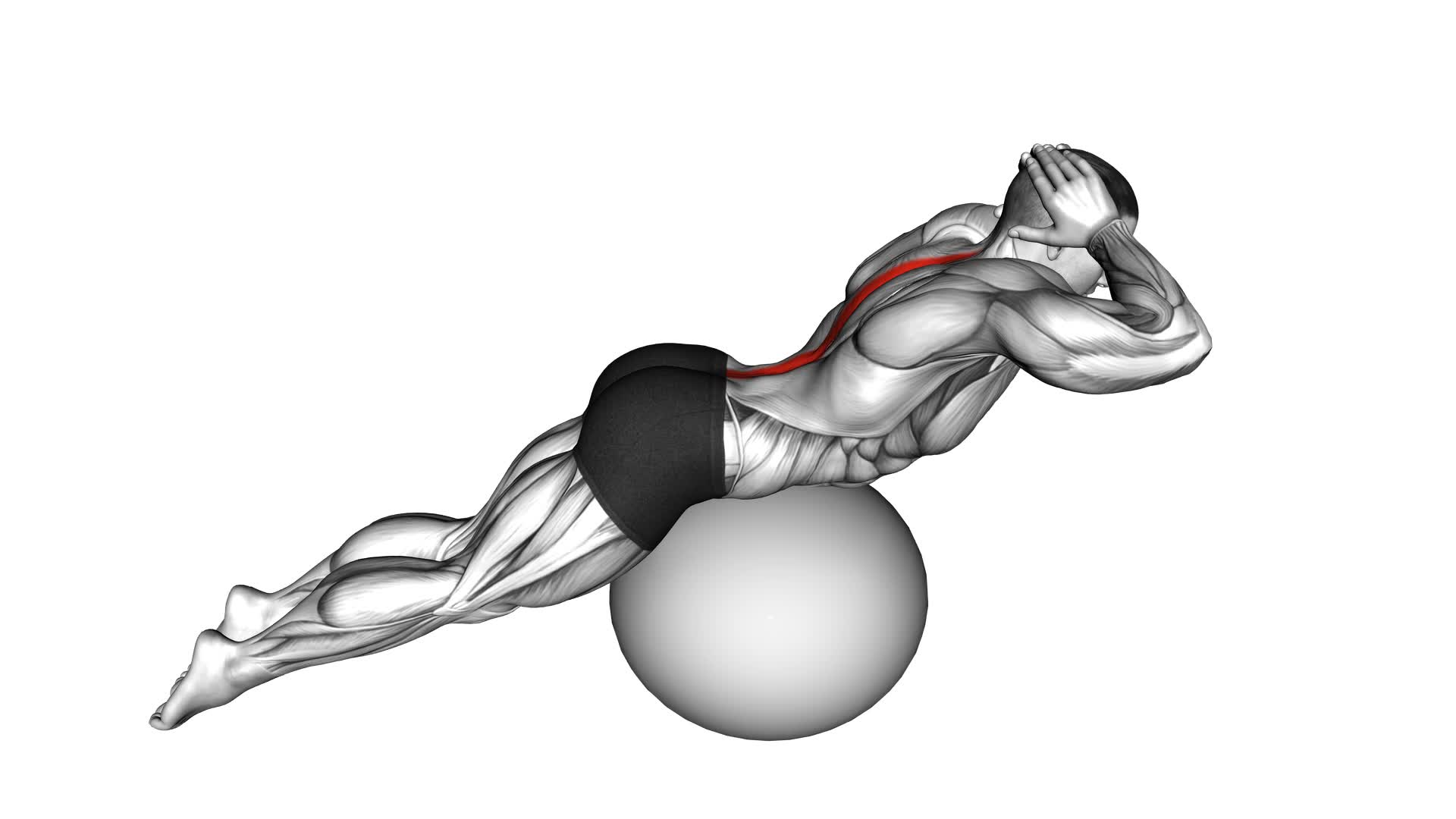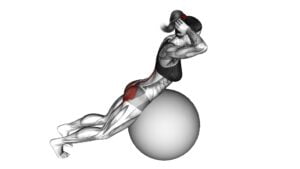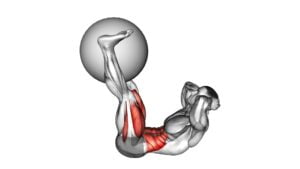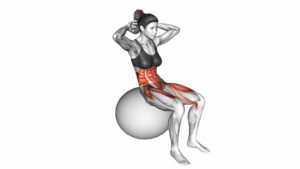Back Extension on Exercise Ball – Video Exercise Guide & Tips

Are you looking to strengthen your back muscles? Get ready to try the Back Extension on Exercise Ball.
Watch This Exercise Video
This exercise targets your lower back and helps improve posture and stability. In this video exercise guide, you'll learn the proper form and technique, as well as common mistakes to avoid.
With variations and progressions, you can challenge yourself and take your workout to the next level. Follow our tips to incorporate this effective exercise into your routine.
Let's get started!
Key Takeaways
- Back extension on an exercise ball strengthens lower back muscles and engages core muscles for balance and stability.
- It increases spinal flexibility, improves posture, and reduces the risk of lower back strain and injury.
- The proper form and technique involve correct ball positioning, core engagement, and controlled movements.
- Common mistakes to avoid include excessive arching of the lower back, using momentum to lift the body, and not maintaining proper form and engaging core muscles.
Benefits of Back Extension on Exercise Ball
You can experience improved spinal flexibility and strength by incorporating back extensions on an exercise ball into your workout routine.
This equipment benefits your body in multiple ways.
Firstly, performing back extensions on an exercise ball helps to strengthen the muscles in your lower back, including the erector spinae, which play a crucial role in maintaining proper posture and spinal alignment. By strengthening these muscles, you can reduce the risk of lower back strain and injury.
Secondly, the exercise ball provides an unstable surface, which engages and activates your core muscles, including the abdominals and obliques, to maintain balance and stability during the movement. This not only enhances the effectiveness of the exercise but also improves overall core strength and stability.
Additionally, using an exercise ball for back extensions allows for a greater range of motion, as it encourages spinal extension and flexion. This increased range of motion helps to improve spinal flexibility, which can alleviate stiffness and improve overall mobility.
Equipment Needed for Back Extension on Exercise Ball
To perform back extensions on an exercise ball, you'll need a stable exercise ball and a comfortable exercise mat. The exercise ball should be large enough to support your body weight and provide stability during the movement. Look for an exercise ball that's made of durable material and has a weight capacity suitable for your body weight. It's important to choose a ball that's the right size for your height. A general guideline is to choose a ball that allows your knees to be at a 90-degree angle when you sit on it. This will ensure proper alignment and stability during the exercise.
In addition to the exercise ball, it's recommended to use a comfortable exercise mat to provide cushioning and support for your body. The mat should be thick enough to provide adequate padding, yet not too bulky that it interferes with your range of motion. Look for a mat that's non-slip to prevent any accidents or injuries while performing the exercise.
When using the exercise ball for back extensions, it's important to ensure stability. Place the ball on a flat and even surface to prevent it from rolling or tipping over. It's also helpful to position the ball against a wall or sturdy object for added stability. This will allow you to focus on the exercise without worrying about the ball moving or slipping. Remember to always maintain proper form and engage your core muscles for stability throughout the movement.
Proper Form and Technique for Back Extension on Exercise Ball
To perform the back extension on an exercise ball with proper form and technique, it's important to focus on three key points.
First, ensure correct ball positioning for stability by placing it under your hips and lower abdomen.
Second, engage your core muscles throughout the exercise to maintain stability and control.
Lastly, be mindful of avoiding lower back strain by using controlled movements and not overextending your spine.
Remember to follow these points to maximize the effectiveness and safety of your back extension on the exercise ball.
Ball Positioning for Stability
Position the exercise ball under your lower abdomen for optimal stability during back extensions. This ball positioning is crucial for maintaining proper form and technique while performing this exercise. By placing the ball in the correct position, you can enhance ball stability and improve your balance training.
Here are five key points to keep in mind:
- Ensure that the ball is centered under your lower abdomen, providing a stable base for your movements.
- Keep your feet shoulder-width apart to maintain balance and stability throughout the exercise.
- Engage your core muscles to support your back and maintain a stable position on the ball.
- Relax your neck and shoulders, allowing them to remain in a neutral position throughout the exercise.
- Control your movements and avoid any sudden jerks or excessive arching of the back.
Engaging Core Muscles
Now, let's focus on how you can engage your core muscles to maintain proper form and technique during back extensions on the exercise ball. Core activation is essential for stability and to prevent strain on your lower back. As you perform the back extension, imagine pulling your belly button towards your spine to engage your abdominal muscles. This will help stabilize your torso and protect your lower back.
Additionally, you can incorporate strengthening exercises for your core, such as planks and bird dogs, into your workout routine to further enhance your core stability. By consistently engaging your core muscles during back extensions and incorporating core strengthening exercises, you can improve your overall form and technique while preventing lower back strain.
Now, let's discuss how to avoid lower back strain during back extensions on the exercise ball.
Avoiding Lower Back Strain
Engage your core muscles to maintain proper form and technique during back extensions on the exercise ball, thereby avoiding lower back strain. By following these guidelines, you can prevent back injuries and strengthen your lower back muscles effectively:
- Begin by positioning yourself face-down on the exercise ball, with your feet firmly planted on the ground.
- Place your hands behind your head or across your chest, whichever is more comfortable for you.
Slowly lift your upper body off the ball, extending your back while keeping your core engaged.
Hold the contracted position for a moment, then slowly lower yourself back down to the starting position.
Remember to breathe throughout the exercise, exhaling as you lift and inhaling as you lower.
Common Mistakes to Avoid During Back Extension on Exercise Ball
To avoid common mistakes during the back extension on an exercise ball, focus on maintaining proper form and engaging your core muscles. By doing so, you can prevent strain and maximize the effectiveness of the exercise.
One common mistake to avoid is arching your lower back excessively. This can strain the muscles and ligaments in your back and lead to discomfort or injury. Instead, keep your back in a neutral position throughout the movement.
Another mistake to watch out for is using momentum to lift yourself up. This takes away from the targeted muscles and reduces the benefits of the exercise. Instead, focus on using your back muscles to lift your upper body off the ball.
It's also important to avoid overextending your neck. This can strain the muscles in your neck and lead to pain or discomfort. Instead, keep your neck in line with your spine and maintain a neutral position.
Lastly, make sure to use a properly sized exercise ball. Using a ball that's too small or too large can affect your stability and increase the risk of injury.
Variations and Progressions of Back Extension on Exercise Ball
To progress your back extension on an exercise ball, you can try incorporating different variations of the exercise. By doing so, you can challenge your muscles in new ways and continue to make improvements in your strength and stability. Here are some variations and progressions you can try:
- Single leg back extension: Lift one leg off the ground while performing the exercise to increase the difficulty and engage your core and glute muscles even more.
- Weighted back extension: Hold a dumbbell or a weight plate against your chest while performing the exercise to add resistance and further strengthen your lower back muscles.
- Superman back extension: Extend your arms out in front of you while performing the exercise, mimicking the position of Superman flying through the air. This variation adds an extra challenge for your back muscles.
- Side-to-side back extension: Instead of lifting straight up, rotate your torso from side to side as you lift, targeting your oblique muscles and adding a rotational element to the exercise.
- Swiss ball back extension: Perform the exercise on a Swiss ball instead of a regular exercise ball. The instability of the Swiss ball will engage more muscles and challenge your balance and coordination.
Incorporating these variations and progressions into your back extension routine will help keep your workouts interesting and continue to challenge your muscles for maximum results.
Tips for Incorporating Back Extension on Exercise Ball Into Your Workout Routine
To effectively incorporate back extension on an exercise ball into your workout routine, it's important to focus on proper form techniques. Keep your core engaged and maintain a neutral spine throughout the movement.
This exercise can help improve your posture, strengthen your back muscles, and enhance overall stability.
Proper Form Techniques
You can achieve proper form and effectively incorporate back extensions on an exercise ball into your workout routine. To ensure you're performing the exercise correctly, here are some tips:
- Choose the right exercise ball size based on your height and weight. This will provide stability and support during the movement.
- Position yourself on the ball with your lower abdomen and hips resting on top, and your feet flat on the ground.
- Place your hands behind your head or across your chest to support your upper body.
- Engage your core muscles and exhale as you lift your upper body off the ball, extending your spine.
- Inhale as you lower yourself back down to the starting position.
Benefits of Back Extension
Incorporating back extensions on an exercise ball into your workout routine can provide numerous benefits for your overall fitness.
One important aspect to consider is ball selection. Choose a ball that's the right size for your height and weight to ensure stability and proper alignment during the exercise.
Additionally, focusing on proper breathing techniques can enhance the effectiveness of the back extension exercise. As you extend your back on the exercise ball, inhale deeply through your nose, filling your lungs with air. Exhale slowly through your mouth as you return to the starting position. This controlled breathing helps engage your core muscles and improves stability throughout the movement.
Frequently Asked Questions
Can Back Extension Exercises on an Exercise Ball Help Alleviate Lower Back Pain?
Back extension exercises on an exercise ball can be beneficial for alleviating lower back pain. They're considered to be one of the best exercises for lower back pain relief.
By targeting and strengthening the muscles in your lower back, these exercises can help improve your posture and stability, reducing the likelihood of experiencing pain.
Incorporating back extension exercises into your routine may provide long-term benefits and contribute to a healthier, pain-free back.
How Often Should I Perform Back Extension Exercises on an Exercise Ball?
To get the most benefits from back extension exercises on an exercise ball, it's important to know how often to do them. Consistency is key! Aim to perform these exercises at least 2-3 times per week.
This frequency will help strengthen your lower back muscles and improve your flexibility. Remember to maintain proper form and technique throughout the exercise to avoid any potential injuries.
Keep up the good work!
Can Back Extension Exercises on an Exercise Ball Improve My Posture?
Performing back extension exercises on an exercise ball can indeed improve your posture. By targeting the muscles in your back and core, these exercises help strengthen and stabilize your spine, promoting proper alignment.
The instability of the exercise ball also engages more muscles, enhancing the overall effectiveness of the workout. Regularly incorporating back extension exercises on an exercise ball into your routine can lead to better posture and a stronger core.
Can Back Extension Exercises on an Exercise Ball Help Strengthen My Core Muscles?
Back extension exercises on an exercise ball can be a great way to strengthen your core muscles. By performing these exercises, you engage your abdominal and back muscles, which helps improve stability and balance.
The exercise ball adds an element of instability, forcing your core muscles to work harder to maintain proper form. The benefits of using an exercise ball for back extensions include increased core strength, improved posture, and reduced risk of back pain.
Are There Any Modifications or Alternatives for Back Extension Exercises on an Exercise Ball for Individuals With Limited Mobility?
If you have limited mobility, there are modifications and alternatives for back extension exercises on an exercise ball. These modifications can help you strengthen your core muscles without putting too much strain on your body.
By using a stability ball, you can adjust the range of motion and intensity to suit your needs.
Alternatively, you can try other exercises that target your core muscles, such as seated back extensions or bird dogs.
Conclusion
Incorporating back extensions on an exercise ball into your workout routine can provide numerous benefits for your back strength and flexibility. By using the proper form and technique, you can effectively engage your back muscles while also avoiding common mistakes.
Additionally, there are variations and progressions of this exercise that can challenge you as you improve. So grab an exercise ball and give back extensions a try to enhance your back workout.

Author
Years ago, the spark of my life’s passion ignited in my mind the moment I stepped into the local gym for the first time. The inaugural bead of perspiration, the initial endeavor, the very first surge of endorphins, and a sense of pride that washed over me post-workout marked the beginning of my deep-seated interest in strength sports, fitness, and sports nutrition. This very curiosity blossomed rapidly into a profound fascination, propelling me to earn a Master’s degree in Physical Education from the Academy of Physical Education in Krakow, followed by a Sports Manager diploma from the Jagiellonian University. My journey of growth led me to gain more specialized qualifications, such as being a certified personal trainer with a focus on sports dietetics, a lifeguard, and an instructor for wellness and corrective gymnastics. Theoretical knowledge paired seamlessly with practical experience, reinforcing my belief that the transformation of individuals under my guidance was also a reflection of my personal growth. This belief holds true even today. Each day, I strive to push the boundaries and explore new realms. These realms gently elevate me to greater heights. The unique combination of passion for my field and the continuous quest for growth fuels my drive to break new ground.







